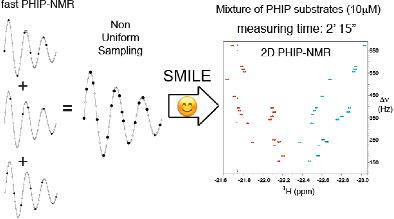当前位置:
X-MOL 学术
›
Magn. Reson. Chem.
›
论文详情
Our official English website, www.x-mol.net, welcomes your feedback! (Note: you will need to create a separate account there.)
An approach to fast 2D nuclear magnetic resonance at low concentration based on p-H2-induced polarization and nonuniform sampling
Magnetic Resonance in Chemistry ( IF 2 ) Pub Date : 2021-06-06 , DOI: 10.1002/mrc.5182 Ruud L E G Aspers 1 , Marco Tessari 1
Magnetic Resonance in Chemistry ( IF 2 ) Pub Date : 2021-06-06 , DOI: 10.1002/mrc.5182 Ruud L E G Aspers 1 , Marco Tessari 1
Affiliation

|
Recent developments in para-hydrogen-induced polarization (PHIP) methods allow the nuclear magnetic resonance (NMR) detection of specific classes of compounds, down to sub-micromolar concentration in solution. However, when dealing with complex mixtures, signal resolution requires the acquisition of 2D PHIP-NMR spectra, which often results in long experimental times. This strongly limits the applicability of these 2D PHIP-NMR techniques in areas in which high-throughput analysis is required. Here, we present a combination of fast acquisition and nonuniform sampling that can afford a 10-fold reduction in measuring time without compromising the spectral quality. This approach was tested on a mixture of substrates at micromolar concentration, for which a resolved 2D PHIP spectrum was acquired in less than 3 min.
中文翻译:

基于p-H2诱导极化和非均匀采样的低浓度快速二维核磁共振方法
对氢诱导极化 (PHIP) 方法的最新发展允许核磁共振 (NMR) 检测特定类别的化合物,低至溶液中的亚微摩尔浓度。然而,在处理复杂的混合物时,信号分辨率需要获取 2D PHIP-NMR 光谱,这通常会导致实验时间过长。这极大地限制了这些 2D PHIP-NMR 技术在需要高通量分析的领域的适用性。在这里,我们提出了快速采集和非均匀采样的组合,可以在不影响光谱质量的情况下将测量时间缩短 10 倍。这种方法在微摩尔浓度的底物混合物上进行了测试,在不到 3 分钟的时间内获得了分辨的 2D PHIP 光谱。
更新日期:2021-06-06
中文翻译:

基于p-H2诱导极化和非均匀采样的低浓度快速二维核磁共振方法
对氢诱导极化 (PHIP) 方法的最新发展允许核磁共振 (NMR) 检测特定类别的化合物,低至溶液中的亚微摩尔浓度。然而,在处理复杂的混合物时,信号分辨率需要获取 2D PHIP-NMR 光谱,这通常会导致实验时间过长。这极大地限制了这些 2D PHIP-NMR 技术在需要高通量分析的领域的适用性。在这里,我们提出了快速采集和非均匀采样的组合,可以在不影响光谱质量的情况下将测量时间缩短 10 倍。这种方法在微摩尔浓度的底物混合物上进行了测试,在不到 3 分钟的时间内获得了分辨的 2D PHIP 光谱。



























 京公网安备 11010802027423号
京公网安备 11010802027423号